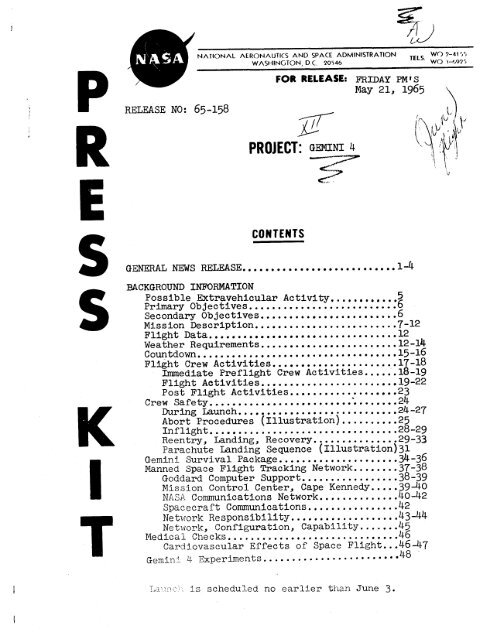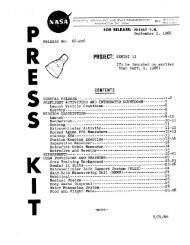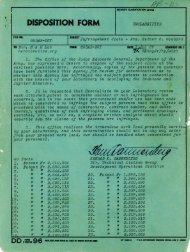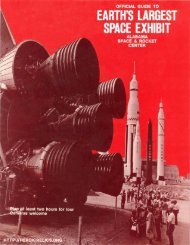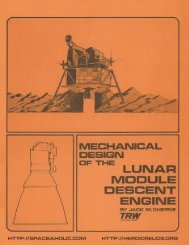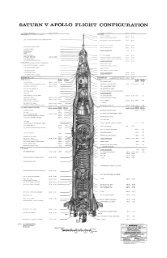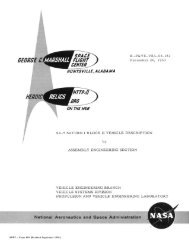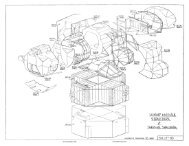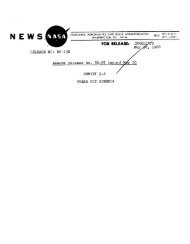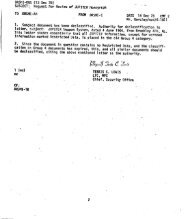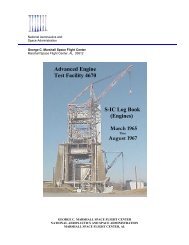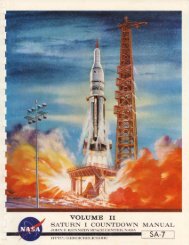Gemini 4 Press Kit - heroicrelics Mirror
Gemini 4 Press Kit - heroicrelics Mirror
Gemini 4 Press Kit - heroicrelics Mirror
- No tags were found...
You also want an ePaper? Increase the reach of your titles
YUMPU automatically turns print PDFs into web optimized ePapers that Google loves.
JIPRELEASE NO: 65-158NATIONAL AERONAUTICS AND SPACE ADMINISTRATION wo 7-41 55WASHINGTON, D C 20546 lELS wo 1-09? 5FOR RELEASE: FRIDAY PPI'sMay 21, 1965RESSKICONTENTSGENERAL NEWS RELEASE. .......................... 14BACKGROUND INFORMATIONPossible Extravehicular Activity.......**...Primary Objectives ..........................Secondary Objectives........................ 6Mission Description ......................... 7-12Flight Data ..................*......*~......12Weather Requirements..... ...................12-14Countdown . ........... 15-16Flight Crew Activities ...................... 17-18Immediate Preflight Crew Activities ...... 18-19Flight Activities ........................l9-22Post Flight Activities.... 23Crew Safety ........................*........24During Launch ............................24-2 7Abort Procedures (Illustration)..........25Inflight .................................28-2 9Reentry, Landing, Recovery ............... 29-33Parachute Landing Sequence (Illustration) 31<strong>Gemini</strong> Survival Package ..................... 34-36Manned Space Flight Tracking Network ........3 7-38Goddard Computer Support ................. 38-39Mission Control Center, Cape Kennedy .....39 -40MASA Communications Network. .............40-42Spacecraft Communications ................ 42Network Responsibility.. .................43-44Network, Configuration, Capability ....... 45Medical Checks ..............................46Cardiovascular Effects of Space Flight.. .46-47048Gemin" i\ Fxperiments.. .....................2*;,+ti- 1 - is schecluled no earlier t'rian June 3.I
In-Flight Phonocardiogram ................ 49Bond Demineralization .................... 49Electrostatic Charge ..................... 0-51Proton-Electron Spectrometer ............. 51-52Tri-Axis Flux-Gate Magnetometer ..........53-54Two-Color Earth's Limb Photography ....... 9-56Synoptic Terrain Photography .............5 7-59Synoptic Weather Photography ............. 60-62Food for <strong>Gemini</strong> 4 ........................... 63 -64<strong>Gemini</strong> 4 Menu ............................ 65-68<strong>Gemini</strong> Spacecraft ........................... 69Reentry Module ........................... 69-70Adapter Section ......................... .70-76Liquid Rocket Systems (Illustration)..... 71Thrust Chamber Arran ement (Illustration)72Maneuvering Control 7 Illustration) ....... 73Response to Control Thrust (Illustration)74RCS Function (Illustration) .............. 75<strong>Gemini</strong> Launch Vehicie ...................... .7 7-80<strong>Gemini</strong> Space Suit ........................... 8 1-82Crew Biographies ............................ 83James A . McDivitt ........................ 83Edward H . White I1 ....................... 84Frank Borman ............................. 85James A . Lovell, Jr ...................... 86Project Officials ........................... 8'7Previous <strong>Gemini</strong> lights ..................... 8 8-90Orbits-Revolutions .......................... 91- 0 -NOTE TO EDITORS:Supplemental information will be releasedas rapidly as it develops .
NATIONAL AERONAUTICS AND SPACE ADMINISTRATION wo 2-4155NEWS WASHINGTON, D.C. 20546 TELS. WO 3-6925RELEASE NO: 65-158FOR RELEASE: FRIDAY PM~sMay 21, 1965NASA SCHEDULES FOUR-DAYMANNED GEMINI FLIGHTFROM CAPE KENNEDYThe National Aeronautics and Space Administration willlaunch the United States' longest duration manned spaceflight to date from Cape Kennedy, Fla., no earlier than June 3.The two-man <strong>Gemini</strong> 4 mission is scheduled to circle theEarth 62 times in four days to evaluate the effects of extendedspace flight on crew performance and physical condition.Astronaut James A. McDivitt is command pilot and AstronautEdward H. White I1 is pilot for the flight. Astronauts FrankBorman and James A. Lovell, Jr., the back-up crew, will replacethe primary crew should either member of that team becomeineligible for the flight.The mission is designated <strong>Gemini</strong> 4--the fourth of 12flights planned in the <strong>Gemini</strong> project.<strong>Gemini</strong> 1 and <strong>Gemini</strong> 2, were wunanned.The first two missions,Astronauts VirgilGrissom and John Young orbited the Earth three times March23 in <strong>Gemini</strong> 3.- more -
- 2 -A successful f’ull-duration <strong>Gemini</strong> 4 flight will morethan triple the manned space flight time accumulated by theUnited States.To date the U.S. has nearly 65 man-hours inspace and the <strong>Gemini</strong> 4 mission would bring the total toabout 257 man-hours. Total U.S. manned spacecraft time in spacewould be about 154 hours after the 97-hour-and-50-minute <strong>Gemini</strong>4 flight.<strong>Gemini</strong> 4 will be launched by a two-stage Titan 11, amodified U.S. Air Force Intercontinental Ballistic missile,into an orbit with a high point (apogee) 185 miles and lowpoint (perigee) of 100 miles above the Earth.Each orbit willtake about 90 minutes and range between 33 degrees north andsouth of the Equator.Recovery is planned in the Atlantic Ocean about 400miles south of Bermuda.Eleven experiments are planned for <strong>Gemini</strong> 4.Three ofthese are medical, four engineering, two Department of Defenseand two scientific.The medical experiments will study effects of exerciseand work in space, time heart contractions with a phonocardiogramand determine whether bone demineralization takes place on longspace flights.- more -
- 3 -Engineering experiments will measure electrostaticcharges on the spacecraft surface, measure radiation immediatelyaround the spacecraft, monitor direction and amplitude of theEarth's magnetic field with respect to the spacecraft andmake two-color photographs of the Earth's "limb" (the outeredge of brightness).DOD experiments concern radiation measurements inside thespacecraft and simple devices for navigation.Scientific experiments include wide-angle terrain andweather photography.The <strong>Gemini</strong> 4 mission marks the first time that missioncontrol will be exercised at the Manned Spacecraft Center,Houston. The Mission Control Center at Houston was used tomonitor the <strong>Gemini</strong> 3 mission but control of that mission andall the Mercury manned space flights was done at Cape Kennedy.The <strong>Gemini</strong> program is the second phase of the UnitedState's manned space flight program. It is designed to provideexperience in orbiting maneuvers, rendezvous and docking, spaceflights lasting up to 14 days and for manned scientific in-vestigations in space.- more -
- 4 -<strong>Gemini</strong> is under the direction of the Office of MannedSpace Flight, NASA Headquarters, Washington, D.C.,and ismanaged by NASA's Manned Spacecraft Center, Houston. <strong>Gemini</strong>is a national space effort and is supported by the Departmentof Defense in such areas as launch vehicle development,launch operations, tracking and recovery.(BACKGROUND DATA FOLLOWS)- more -
Second stayeseparatio5gRetro adapterEquipment adapterseparation byAtOrient separation at retro crew. Orient alJtIroxiniatelyOrbit to retro fire (TR) minus 30 Retro to reentry 1 .O ft/sec beyiiiphase attitude seconds fire attitude re-eiitry controlDroyue chute deploya 50,000 ft\B\ Pilot chutefairingjettisonSecond stayecut-offBASIC MISSION PHASESPre-launchLaunchOrbitRetrogradeReentryLandingRecoveryR and R sectionjettison andiliain chute de-Secoiid stayei y ii it ion3.4.I dis-reefQ 98800ftIIFirst stayecut-off andjettisonLift-offT+4seconds1.i1. Actuation of "D" handle between legs opens hatchesand fires catapults, thrusting seats clear of spacecraft.2. Rocket portion of rocket catapult iynites, providingcontinued thrust and increased seat velocity.3. Rocket burnout.4. Man - seat separation.5. Droyue motor fires, and chute is deployed.6. Chute iiiflated. Backboard and egress kit released.7. Survival year stripped out on lanyard.<strong>Gemini</strong> 4 Significant Events
- 5 -POSSIBLE EXTRAVEHICULAR ACTIVITYNo decision has been made whether in the <strong>Gemini</strong> 4mission the crew will engage in extravehicular activity.This will depend on the qualifying of the extravehicularspace suits and the hatch.During their training the <strong>Gemini</strong> 4 crew performed asimulated extravehicular test in the vacuum chamber atMcDonnell Aircraft Corp., at a simulated altitude of l50,OOOfeet.A decision to undertake the extravehicular test canbe made as late as the day before the launch.- more -
- 6 -GEMINI 4 PRIMARY OBJECTIVES1. Demonstrate and evaluate performance of the spacecraftsystems for a period exceeding four days.2. Evaluate effects of prolonged exposure to the spaceenvironment of the two-man flight crew in preparation forflights of longer duration.GEMINI 4 SECONDARY OBJECTIVES1. Demonstrate Orbital Attitude and Maneuver System'scapability to perform retrofire back-up.2. Demonstrate capability of the spacecraft and flightcrew to make in-plane and out-of-plane maneuvers.3. Conduct further evaluation of spacecraft systemsas outlined in inflight systems test objectives:a. Structure and thermal protection system.b. Environmental control system.C. Crew station.d. Guidance and control system.e. Orbital Attitude and Maneuver System(oms) .- more -
- 7 -4. Execute the following experiments:a. M-3 inflight exerciser.b. M-4 inflight phonocardiogram.c. M-6 bone demineralization.d. MSC-1 electrostatic charge.e. MSC-2 proton electron spectrometer.f. MSC-3 tri-axis magnetometer.g. MSC-10 two-color Earth's limb photographs.h. D-8 radiation in spacecraft.i. D-9 simple navigation.j. S-5 synoptic terrain photography.k. S-6 synoptic weather photography.MISSION DESCRIPTIONThe spacecraft will be launched from Pad 19 on a trueazimuth of 72 degrees east of north. Slightly more than sixminutes after liftoff, it will be inserted into a 100-185-statute-mile orbit inclined approximately 32.5 degrees tothe Equator. (All miles are statute).- more -
- 8 -Orbital insertion will occur about 680 miles fromCape Kennedy at a velocity of 25,766 feet per second (17,567miles per hour), including up to 10 feet per second providedby the spacecraft's aft-firing thrusters during the separationmaneuver.While in orbit, maneuvers totaling 55 feet per secondwill be used to adjust the orbital lifetime and to demonstratethe maneuvering ability of the spacecraft. Additionalmaneuvers totaling 25 feet per secondwillbe performed separately,but in conjunction with orbit adjustment maneuvers, to checkout operational procedures.Retrofire is planned at 97 hours, 31 minutes and 43seconds after liftoff as <strong>Gemini</strong> 4 is passing over the westcoast of the United States before the end of the 62nd revolu-tion.Landing is expected approximately 17 minutes afterretrofire in the Atlantic Ocean about 400 miles south ofBermuda .Each of the maneuvers will be calculated in realtime andadjusted to meet requirements as determined by the missiondirector. The maneuvers planned are:- more -
- 9 -Separation Maneuver -- Twenty seconds after the launchvehicle's second stage engine cuts off- (SECO), the commandpilot will activate the two aft-firing thrusters for 12seconds to apply up to 10 feet per second forward velocityto the spacecraft to separate it from the launch vehicle.will not control the spacecraft attitude during the firsttwo seconds of thrust, then he will control attitude to 0degrees roll, 0 degrees yaw and -20 degrees pitch for theremainder of the burn.HeAt Second Apogee -- The forward velocity will be increasedseven feet per second to raise the perigee and achieve afive-day lifetime. Prior to burn, the command pilot willyaw the spacecraft 180 degrees, placing the blunt end forward,and the two forward-firing, 85-pound thrust engines will beused for the maneuver. About 11 seconds of thrust will berequired. The perigee of the orbit tdll be raised to 105miles and the apogee will remain at 185 miles.At 30th Apogee -- Forward velocity will be increased 12feet per second to raise the perigee and achieve a three-daylifetime. The 100-pound left-firing thruster will be usedand it will be necessary to yaw the spacecraft -64 degreesto align the thruster with the velocity vector.Thrustingtime will be about 30 seconds.- more -
- 10 -Between 30th Apogee and 30th perigee -- A series offive foot per-second maneuvers will be performed to evaluatethruster operation and to determine visual characteristicsof thruster plumes. The burns will be performed at fiveminuteintervals.The first will be up, using the 100-pound down-firingthruster while the spacecraft is at a -26-degree pitch angleto align the thruster perpendicular to the velocity vector.The second will be down, utilizing the 100-pound upfiringthruster while the spacecraft is at apitch angle of26 degrees to align the thruster perpendicular to the velocityvector.The third will be to the left utilizing the 100-poundright-firing thruster while the spacecraft is at a yawangle of -26 degrees to align the thruster perpendicular tothe velocity vector.Approximately 12 seconds of thrust will be required foreach maneuver.- more -
- 11 -At 30th Perigee -- A maneuver will be performed toevaluate the application of a three-axis change in velocityusing the two 100-pound aft-firing thrusters.The space-craft attitude will be -169.3 degrees yaw and 10.9 degreepitch, Velocity values will be 26 feet per second aft,five feet per second up and five feet per second left. About34 seconds of thrust will be required. At the end of allthe maneuvers beginning at the 30th apogee, the spacecraftwill be in a 108-154-mile orbit.At 45th Apogee -- Forward velocity will be increasedfour feet per second to raise the perigee and achieve atwo-day lifetime. The 85-pound forward-firing thrusterswill be used while the spacecraft is in a 180-degree yawattitude. Burn time will be about seven seconds.At 45th Perigee -- R six-foot aft burn, using theforward firing thrusters, will be made to lowerthe apogee.Spacecraft attitude will be 0 degrees in all axes.Thrustingtime will be about 10 seconds.At the end of the two maneuversin the 45th orbit, ae orbital elements will be 107-143 miles.Twelve minutes before Retrofire -- An Orbital Attitudeand Maneuver System retrograde maneuver of about 110 feetper second will be performed to provide a reentry trajectory- more -
- 12 -even if the retrorockets should not fire. The aft-firingthrusters will be used while the spacccraft is in a 180-degree yaw attitude.Burn time will be about 116 seconds.FLIGHT DATALaunch Azimuth -- 72 degrees.Flight Duration -- Approximately 97 hours, 50 minutes.Initial Orbital Parameters -- 100 -185 miles.Reentry Velocity -- About 24,000 feet per second, 16,450miles per hour.Reentry temperature -- About 3,000 degrees Fahrenheit onsurface of heat shield.Landing Point -- Atlantic Ocean about 400 miles south ofBermuda, 25.20 degrees north, 65 degrees west.Oxygen -- Primary 52 pounds, Secondary 13 pounds.Cabin Environment -- 100 per cent oxygen pressurized atfive pounds per square inch.Retrorockets -- Each of four retrorockets producesapproximately 2,500 pounds of thrwst for 5.5 seconds.W i l lfire separately.WEATHER REQUIREMENTSRecovery capability is based primarily on reportsfrom recovery force commanders to the recovery task force- more -command at Mission Control Center.
- 13 -The following are guide lines only.Conditionsalong the ground track will be evaluated prior to and duringthe mission.Launch AreaSurface Winds -- 18 knots with gusts to 25 knots.Ceiling -- 5,000 feet cloud base minimum.Visibility -- Six miles minimum.Wave Height -- Five feet maximum.Planned Landing AreasSurface Winds -- 30 knots maximumCeiling -- 1,500 feet cloud base minimum.Visibility -- Six miles minimum.Wave Height -- Eight feet maximum.Contingency Landing AreasWeather and status of contingency recovery forces willbe continually monitored.Recommendations will be made to theMission Director who will make the go-no-go decision basedupon conditions at the the.- more -
- 14 -PararescueThe decision to use pararescue personnel depends uponweather conditions, surface vessel locations and the abilityto provide air dropped supplies until the arrival of asurface vessel.the jump-master.The final decision to jump will be made byWeather guidelines for pararescue opera-tions are:Surface Winds -- 25 knots maximum.Ceiling -- 1,000 feet cloud base minimum.Visibility -- Target visible.Waves -- Five feet maximum, swells 10 or 11 feetmaximum.- more -
- 15 -T-1 dayT-270 minutesT-240 minutesT-225 minutesT-190 minutesT-175 minutesT-1.70 minutesT-168 minutesT-150 minutesT-120 minutesT-100 minutesT-60 minutesT-35 minutesT-30 minutesT-25 minutesT-20 minutesT-15 minutesT-6 minutesT-5 minutesT-4 minutesLAUNCH COUNTDOWNPreparations for launch countdown'Awaken crcw .Begin countdown.Engine cutoff, shutdown and destructtest complete.Start electrical connection of Stage Iand I1 destruct iniatiators.Ordnance electrical connections complete,safety pins removed; blockhouse doorsealed.Begin sensor placement and suiting ofcrew.Launch vehicle tank pressurizationcompleted.Start launch vehicle securing preparations.Verify launch vehicle "Go" for flight;simulated malfunction test.Crew enters spacecraft.Nhite Room evacuation complete; erectorlowering preparations complete; erectorcleared to lower.Start lowering erector; start rangetelemetry readout.Activate spacecraft communications links.Spacecraft to internal power.Command transmitter on.Spacecraft static firing.Final status and communications check.Start range telemetry recorders.Start analog and event recorders.- more -
- 16 -T-3 minutes Set in launch azimuth (72 degrees),T-2 minutes, 30seconds Range clearance .T-1 minute, 30 seconds Roll program armed.T-0 Engine start signal.- more -
- 17 -FLIGHT CREW ACTIVITIES, GEMINI 4The <strong>Gemini</strong> 4 flight crew was selected July 27, 1964. Concentratedmission training began in September. In additionto the extensive general training received prior to flightassignment--such as familiarization with high accelerations,zero gravity, and various survival techniques--the followingpreparations have or will be accomplished prior to launch:a. Familiarization with launch, launch abort, andreentry acceleration profiles of' the <strong>Gemini</strong> 4 mission usingthe Naval Air Development Center, Johnsville, Pa., centrifuge.b. Egress and recovery activities using a spacecraftboilerplate model and actual recovery equipment and personnel.c. Celestial pattern recognition in the MooreheadPlanetarium, Chapel Hill, N.C.d. Hatch-open and standup exercises at a simulatedl50,OOO ft. in the McDonnell Aircraft Corp. pressure chamber.e.Parachute descent training over land and water usinga towed parachute technique.f. Zero gravity evaluation of extra vehicular activities,food and other on-board equipment.g. Suit, seat, and harness fittings.h. Launch abort simulations at Ling-Temco-Vought in aconfigured simulator.- more -
- 18 -i. Training sessions totaling over 110 hours per crewmember on the Gemi::i mission simulators.j. Detailed systems briefing; detailed experimentbriefings; flight plan and mission rules reviews.k. Participation in mock-up reviews, Service EngineeringDepartment Report (SEDR) reviews, subsystem tests, and spacecraftacceptance review.In final preparation for flight, the crew participantsin network launch abort simulations, joint combined systemstest, rrJet mock simulated lm,~nck( and the final simulated flighttest. At T-2 days, the major flight crew medical examinationswill be administered to determine readiness for flight andobtain data for comparison with post flight medical examinationresults.Immediate Preflight Crew ActivitiesSeven hours prior to launch, the back-up flight crewreports to the 100-foot level o€ the White Room to monitorthe positioning ~1' all cockpit switches.By T-5 hours, thepilots' ready room, the 100-foot level of the White Room andthe crew quarters are manned and made ready for the primarycrew.- more -
- 19 -T-4 hours, 30 minutes Primary crew awakenedT -4 hoursMedical examinationT-3 hours, 40 minutes BreakfastT-3 hours Crew leaves Q&C (Operationsand Checkout) BuildingT-2 hours, 50 minutes Crew arrives at ready roomon Pad 16During the next hour, the biomedical sensors are placed,underwear and signal conditioners are donned, flight suitsminus helmets and gloves are put on and blood pressure is checked.The helmets and gloves are then attached and communicationsand oral temperature systems are checked.T-2 hours Purging of suit beginsT-1 hour, 49 minutes crew leaves ready roomT-1 hour, 44 minutes Crew arrives at 100-foot levelT-1 hour, 40 minutes Crew enters spacecraftFrom entry until ignition, the crew participates in ormonitors system checks and preparations.Flight kctivitlesAt ignition the crew begins the primary launch phasetask of assessing system status and detecting abort situations.At 45 seconds after staging the command pilot jettisons thenose and horizon scanner fairings. Twenty seconds arter SECO,the command pilot initiates forward thrusting and tine pilot- more -
- 20 -actuates spacecraft separation and selects rate commandattitude control. Ground computations of insertion velocitycorrections are received and velocity adjustments are made byforward or aft thrusting.After successful insertion andcompletion of the insertion check list, the detailed flightplan is begun.In addition to frequent housekeep-tasks such assystems tests, biomedical readouts and eating, the followingsignificant events are planned:Orbit-- Events1 Thruster and control mode check, communicationssystems check, D-9 experiment (star to boostersextant measurements).245 -6Translation manuever and night Apollo yaw orientationcheck.Tracking tasks and synoptic weather photography.Cormand pilot sleeps, MSC-2 experlment (proton electronmeasurement), MSC-3 (magnetic field measurement),l'4-3 (exercise) and MSC-10 (two-color Earth limbphotography).8Command pilot awakes, D-8 experiment (radiation'measurements), pilot sleeps.- more -
- 21 -91112131617192021222325262728293031D-9 experklent (star and horizon sextant sightings) .Pilot awakes.M-3 (exercise).Command pilot sleeps.S-5 (synoptic terrain photography), command pilotawakes, pilot sleeps.High frequency communications tests.Pilot awakes, D-9 (star and horizon sextant measurements),Command pilot sleeps S-6 (synoptic weather photography).MSC-2 (proton and electron measurements) , MSC-3(magnetic field measurements), D-8 (radiationmeasurements), S-5 (synoptic weather photography).D-8 (radiation measurements), S-5 (synoptic weatherphotography).Command pilot awakes, pilot sleeps.Pilot awakes.M-3 (exercise).Command pilot sleeps, S-6 (synoptic weather photography).S-5 (synoptic terrain photography).S-6 (synoptic weather photography), M-3 (exercise).Command pilot awakes, translation maneuvers.Power down spacecraft, pilot sleep starts, S-5(synoptic terrain photography) , S-6 (synoptic weatherphotography).- more -
- 22 -3334Pilot awakes.M-3 (exercise).I35Command pilot sleeps D-9 (star to horizon sextantmeasurements), MSC-2 (proton and electron measurements),MSC-3 (magnetic field measurements).363733S-6 (synoptic weather photography).S-6 (synoptic weather photography).Command pilot awakes, pilot sleeps, D-9 (sextantmeasurements).40454647Pilot awakes.Power up and align platform.Translation maneuver, M-3 (exercise).Translation maneuvers, Apollo yaw orientation, pilot49sleeps.Pilot awakes, M-3(exercise).505355576052D-9 (sextant measurements), command pilot sleeps.Command pilot awakes, pilot sleeps.Pilot awakes.M-3 (exercise).M-3 (exercise), end of missions systems checkout,Pre-retro checklist, T R -5-minute checklist, T R -1-minute checklist, retrofire, retro jettison, post-retro checklist.63Reentry, drogue deploy, main chute deploy, two-point suspension, impact, post-landing checklist,- more -
- 23 -Post Fll.ght ActivitiesThe post flight activities will involve expandedmedjcal evaluations compared with previous missions. It isplanned the flight crew will spend three nights aboard therecovery carrier performing taped debriefings and undergoingextensive medical examinations. They will return to Houstonfor a press conference and then will report for more extensivemedical examinations and complete systems debriefings foreight to 10 days after recovery.- more -
- 24 -CREW SAFETYCrew safety is paramount.<strong>Gemini</strong> represents thousandsof hours of design, modification, fabrication, inspection,testing and training. Every component or system critical tocrew safety has a redundant (back-up) feature.During LaurichThe malfunction detection system (MDS) in the launchvehicle is the heart of crew safety during the powered phaseof flight -- lift-off to second stage shut-down.This system was designed for the <strong>Gemini</strong> launch vehicleand had no counterpart in the Titan weapon system. Its functionis to monitor <strong>Gemini</strong> launch vehicle subsystem performanceand warn the crew of a potentially catastrophic malfunctionin time for escape, if necessary.The MDS monitors enginethrust for both stages, steering rates, propellant tank pres-sures, staging, Stage I hydraulic pressure, a spacecraftswitchover command or engine hardover.During the powered phase of flight there are three modesfor crew escape.These are (1) ejection seats, (2) firing the- more -
- 25 IABORT PROCEDURESMODE I - EJECT AFTER SHUTDOWNMODE II - SALVO RETROS AFTER SHUTDOWNMODE I - SHUTDOWN, SEPARATE, TURN AROUND,RETROFIREMODE-20,700 FPSVELOCITY5 MlN. 10 SEC.78,000 FT.15,000 FT.tu
- 26 -retrorockets to separate the spacecraft from the launch ve-hicle, then initiating the spacecraft recovery system, (3)normal spacecraft separation followed by use of the thrustersand retrorockets.For malfunctions dictating retro-abort modewhich occur between 15,000 and 76,000 feet, the astronauts willnot initiate abort until aerodynamic pressure has decreased tothe point where successful separation of the spacecraft fromthe launch vehicle is assured.Escape procedures will be initiated by the command pilotfollowing two valid cues that a malfunction has occurred.Theparticular malfunction and the time at which it occurs willdetermine abort procedures as follows:1. Lift-off to 15,000 feet (50 seconds) -- Immediateejection for all malfunctions.2. 15,000 (50 seconds) to 78,000 feet (100 seconds) --Delayed retro-abort for all malfunctions.This action consistsof arming abort circuits, waiting until aerodynamic pressurehas decreased, then salvo firing the four retrorockets to sepa-rate from the launch vehicle.five seconds.This delay requires approximately3. After the launch vehicle is above 78,000 feet, aero-dynamic drag will have decreased to the point where no delay-more -
- 27 -between engine shutdown and retro-abort is required for sue-cessful. separation.Retro-abort will be used until a velocityof approximately 20,700 ft/sec (14,000 mph) or 80 percent ofthat required to get into orbit is achieved. For rapid malfunctions,retro-abort will be initiated immediately afterreceipt of two valid cues. For slow malfunctions and mostspacecraft malfunctions, retro-abort will be initiated at afixed time in order to land near pre-positioned recovery vessels.In boost-phase aborts where more than 80 percent ofvelocity required for orbit has been achieved, the normalspacecraft separation sequence is used for all malfunctions.The most probable cause of abort in this area would be earlyshutdown of the booster due to fuel depletion.Also, abortmight be requested by ground monitors if the trajectory ex-ceeds acceptable limits.The general abort plan in thisflight regime is to separate from the launch vehicle, assumeretroattitude, insert landing area parameters in the space-craft computer, retrofire, and descend to a planned recoveryarea .- more -
- 28 -InflightThere are no single point failures which would jeopardizecrew safety during inflight operations.A l l systems and sub-systems have back-up features or there is an alternate method.The Environmental Control System (ECS) controls suit andcabin atmosphere, crew and spacecraft equipment temperaturesand provides drinking water and a means of disposing of wastewater.Thespace suit itself Is a back-up system.pressure fail, the spacesuit provides life support.Should cabinIt is a full pressure suit which works in conjunctionwith the ECS. Gaseous oxygen is distributed through the suitventilation system fir coolingallow the astronaut to take inand respiration and provisionsdrinking water while in a hardsuit (pressurized) condition.A 100-percent oxygen environment at 5 pounds per squareinch in a pressurized cabin or 3.7 psia in an unpressurizedcabin is provided in spacesuit by the ECS. Additional oxygen-more -
- 29 -is available from tanks in the reentry module in case ofemergency and for use during reentry.In event the flight must be terminated before missioncompletion, the <strong>Gemini</strong> propulsion systems will permit acontrolled landing in a contingency recovery area.Reentry, Landing and RecoveryThe Reentry Control System (RCS) controls the spacecraftattitude during retrorocket firing and reentry. Two completeand independent systems provide 100 percent redundancy. Thefour retrorockets are wired with dual igniters.The Orbit Attitude and Maneuver System (OAMS) serves asa back-up safety feature should the retrorockets fail to fire.In case of retrorocket failure the OAMS will have been usedto lower the orbit to the point where grav.ity and atmosphericdrag would cause spacecraft reentry.The OAMS is normally used to perform translation maneu-vers along three axes of the spacecraft and provide attitudecontrol during orbital phases of the mission.- more -
- 30 -In <strong>Gemini</strong> 4, should the retrorockets fail, reentry willoccur near Ascension Island in the South Atlantic.Parachutes are used for descent following spacecraftreentry.The crew has an excellent view of parachute de-ployment through the spacecraft windows. If there is a parachutemalfunction the crew will eject themselves from the spacecraftand use their personal chutes for landing. Survivalequipment is carried on the backs of the ejection seats andremains attached to the astronauts until they land.Recovery forces will be provided by the military servicesand during mission time will be under the operationalcontrol of the Department of Defense Manager for Manned SpaceFlight Support Operations.Planned and contingency landing areas have been estab-lished.Planned areas are those where the probability of land-ing is sufficiently high to justify pre-positioning of recoveryforces for support and recovery of crew and spacecraft withingiven access times.- more -
- 31 -GEMINI PARACHUTE LANDING SEQUENCE50,000 FEET -- HIGH ALTITUDEDROGUE CHUTEDEPLOYED21,000FEET -10,600 FEET -9,600 FEET -9,000 FEET -OPENCABIN VENTVALVE- PILOT PARACHUTEDEPLOYED-R 8, R SECTIONSEPARATION- MAIN CHUTEDEPLOYMENT6,700 FEET -TWO -POINTSUSPENSIONSEA LEVEL- 2 TOUCHDOWN- CABIN WATERSEAL CLOSED
- 32 -Contingency areas are all other areas along the groundtrack where the spacecraft could possibly land. The probabilityof landing in a contingency area is sufficiently low that specialsearch and rescue techniques will provide adequate recoverysupport.There are four types of planned landing areas:1. Primary Landing Area -- Landing will occur with normaltermination of the mission after 63 orbits. This area is inthe Atlantic Ocean, about 400 miles south of Bermuda.2. Secondary Landing Areas -- where a landing would occurif it is desirable to terminate the mission for any cause.Ships and aircraft will be stationed to provide support.Air-craft will be able to drop pararescue personnel and flotationequipment within one hour after spacecraft landing.3. Launch Abort Landing Areas -- Along the launch groundtrack between Florida and Africa where landings would occurfollowing aborts above 45,000feet and before orbital insertion.Surface ships with medical personnel and retrieval equip-ment, and search and rescue airplanes with pararescue personnel,flotation equipment and electronic search capability will bestationed in this area before launch.After the successful in-sertion of the spacecraft into orbit, some of the ships andplanes will deploy to secondary areas to provide support on alater orbit, and the remainder will return to home stations.- more -
- 33 -4, Launch Site Landing Area -- Landing will occurfollowing an abort during countdown, launch and early poweredflight in which ejection seats are used. It includes an areaof approximately 26 miles seaward and three miles toward theBanana River from Pad 19. Its major axis is oriented alongthe launch azimuth.A specialized recovery force of land vehicles, amphibiouscraft, ships and boats, airplanes and helicopters willbe stationed in this area from the time the astronauts enterthe spacecraft until lift-off plus five minutes.Recovery access time varies from 0 minutes for a water1- to 10 minutes for a land landing. The astronauts willbe taken to the Patrick Air Force Base hospital for examinationsafter pickup.Contingency Landing Areas:Search and rescue aircraft equipped with electronic searchequipment, pararescue men and flotation equipment will be stagedalong the ground and sea track so that the spacecraft will belocated and assistance given to the astronauts within 18 hoursafter the recovery forces are notified of the probable landingposition.- more -
- 34 -GEMINI SURVIVAL PACKAGEThe <strong>Gemini</strong> survival package contains 14 items designedto support an astronaut if he should land outside normalrecovery areas.The package weighs 23 lbs. and has two sections.section, holding a 33-pound water container and macheteOneis mounted by the astronaut's left shoulder.The main package,containing the life raft, and related equipment, is mountedon the back of the ejection seat.Both packages are attachedto the astronaut's personal parachute harness by a nylonline.After ejection from the spacecraft, as the seat fallsclear and the parachute deploys, the survival kit will hangon a line, ready for use as soon as the astronaut lands.Inflated, the one-man life raft is five and one halfft. long and three ft. wide. A CO bottle is attached for2inflation. The raft is also equipped with a sea anchor, seadye markers, and a sun bonnet of nylon material with analuminized coating which the astronaut can place over hishead- more -
- 35 -In his survival kit, the astronaut also has a radiobeacon, a combination survival light, sunglasses, a medicalkit, and a desalter kit assembly.The combination survival light is a new developmentfor the <strong>Gemini</strong> kit, combining many individual items whichwere carried in the Mercury kit. About the size of a paperbacknovel, it contains a strobe light for signaling atnight, a flashlight, and a signal mirror bu2lt in on theend of the case.It also contains a small compass.There are three cylindrical cartridges inside thecase. Two contain batteries for the lights. The thirdcontains a sewing kit, 14 feet of nylon line, cotton ballsand a striker for kindling a fire, halazone tablets forwater purification and a whistle.The desalter kit includes eight desalter brickettes,and a processing bag,Each brickette can desalt one pint ofseawater.- more -
- 36 -The medical kit contains a one-cubic-centimeter injectorfor pain, and a two-cubic-centimeterinjector for motionsickness.There also are stimulant, pain, motion sickness,and antibiotic tablets and aspirin.- more -
- 37 -MANNED SPACE FLIGHT TRACKING NETWORKThe Manned Space Flight Network for <strong>Gemini</strong> 4 is composedof spacecraft tracking and data acquisition facilitlesthroughout the world, a Mission Control Center at Cape Kennedy,a real - time (no delay) computing and communications centerat the Goddard Space Flight Center, Greenbelt, Md., and a MissionControl Center in NASA's Manned Spacecraft Center, Houston.The basic network consists of seven primary land sites,two ships, (the Rose Knot and Coastal Sentry) six additionalland stations, and remote voice dataswitching sites. Thisnetwork and its operating procedures remain unchanged from the<strong>Gemini</strong> 3 mission, however, primary mission control and computingresponsibilities will switch from the Mission Control Center,Cape Kennedy, and Goddard Space Flight Center, to the MannedSpacecraft Center.The locations of the land stations areas follows:PrimaryAdd.- Stations - tional StatCape Kennedy, Fla., and down-Kano, Nigeria-.onsrange A ir Force Eastern TestMadagascar (Tananarive)Range sitesBermudaGrand Canary IslandCanton IslandPo3.nt Arguello, Calif.-- more -
- 33 -Carnarvon, AustraliaHawaiikhite Sands, N.M.Egliri AFB, Fla.Guaymas , MexicoCorpus Christi, Tex.Two Ships: The Rose Knotand Coastal SentryOther tracking and data acquisition facilities, such asrelay aircraft, instrumentation ships, communications. relaystations, etc., wi-ll be called up as required and integratedinto the basic network.Countdown.- ->phase--The - Goddard Realtime Computing Centerwill provide back-up computing support to the Manned SpacecraftCenter Realtime Computing Complex throughout the mission.During the pre-launch countdown Goddard will be responsible forchecking the Manned Space Flight Network's readiness to support<strong>Gemini</strong> 4 through its CADFISS (Computer and Data Flow IntegratedSubsystems) Tests.The Goddard Realtli-me Computing Center also will provideprime computer support for all netowrk tracking and dataacquisition systems (Radars-Digital Command System-Pulse CodeModulation telemetry and the Launch Monitor Subsystem) rollcall.- more -
- 39 -Data flow tests from the world-wide network to theManned Spacecraft Center's Realtime Computing Complex willbe conducted from MSC RTCC under the direction of Goddard'sCADF'ISS Test Director.- Launch Phase--During powered fli-ght, Goddard'scomputers will receive launch trajectory data fromr ealtimeJASA s Bermuc .atracking station, compute the trajectory and display thedata on plotboards and consoles at Mission Control Center,Cape Kennedy.Orbit Phase--During the orbit phase, Goddard's computingcenter will update the 0rbj.t based on data received from networkradars. Refined orbital parameters will be displayed at MissionControl Center, Cape Kennedy as required.Mission Control Center - Cape KennedyThe Mission Control Center, Cape Kennedy is technicallysupervised, operated and maintained by Goddard.During <strong>Gemini</strong>4 it will be full-time back-up to Mission Control Center,Houston.It will operate on a 24-hour basis in concert withHouston Mission Control requirements.- more -
- 40 -During the launch phase, Kennedy Mission Control willprovide realti-me data display and command control capabilityl'or i.ts flight control team.In the event of communicationsbreakdown from Houston, the Kennedyflight-control team w i l lbe able bo assume flight direction and control immediately.Kennedy Mission Control also will provide flight dynamicsdata simultaneously to Goddard and Houston computers for thecrj tical "GO-NO-GO'' orbital insertion decision.All <strong>Gemini</strong>Launch Vehicle and spacecraft telemetry data acquired byAir Force Eastern Test Range stations are processed in realtime at Kennedy Mission Control and forwarded to the HoustonMSC Realtime Computer Complex.For the first time, Kennedy IvIission Control will provlidea control center position to the <strong>Gemini</strong> spacecraft checkoutteam.In the past this has not been possible because ofspace limitations.The team will be available for spacecraftsystems analysis throughout the mission.NASA Communications Network (NASCOM)This Division, a Goddard responsibility, will establishand operate the world-wide ground communications networkthat provj-des teletype, voice, and data links between thestations and control centers for tke rletwork.- more -
- 41 -It links 39 stations, including 3°C overseas points, withmessage, voice and data communications. Its circuits andterminals span 100,000 route miles and 500,000 clrcuit miles.For <strong>Gemini</strong> 4 the Communications Network (NASCOM) w i l l beused in ",he same basic configuration as for <strong>Gemini</strong> 3. Severalvoice and data circuits between Goddard and Houston MissionControl have been added to accommodatc: the increase in traffic.During <strong>Gemini</strong> 3, voice communication with the spacecraftvia the Syncom I1 communications satellite and NASCOM groundstations was successfully achieved over the Indian Ocean. For<strong>Gemini</strong> 4 a similar exercise is planned using the Syncom I11communications satellite stationed over the Pacific Ocean.Also part of NASCOM is the voice communication net.A switchboard system, with multiple dual-operating consoles,enables one operator to concentrate on special mission conferences.This system is called SCAMA I1 (Stati-on Conferencing andMonitoring Arrangement).SCAMA I1 can now handle 100 lines andcan ultimately be expanded to handle 220 lines.Both point-to-point connections and conference arrangements are possible.All lines can be connected into one conference without loss of'quality.The SCAMA operator can add conferees or remove them.He also controls which of the conferees can talk and which canlisten only.- more -
- 42 -The SCAMA has 10 times the capability of the networkused for Mercury.Spacecraft Communications -All Manned Space Flight Network statlons having bothhigh frequency (HF) and ultra high frequency (UHF) space-craft communications can be controlled either by the stationor remote controlled by Goddard.or Kennedy Mission Control.Houston Mission ControlThe following sites will have a Capsule Communicatorwho will control spacecraft communications at the site:CanaryIsland; Carnarvon; Kuai, Hawaii; Corpus Christi; Guaymas;Rose Knot; and Coastal Sentry.The following stations will not ha re Capsule Commiand will be remoted to the appropriate Mission ControlnicatorsCenter:Grand Bahama Island; Tananarive (Madagascar); Kano, Nigeria;9ermuda; Grand Turk Island; Antigua Island; Ascension Island;Canton Island; Pt. Arguello, Calif.; Range Tracker (ship) andthe voice relay aircral't.- more -
- 43 -Network ResponsibilityGoddard Space Flight Center. NASA's Office of Trackingand Data Acquisition has centralized the responsibility forthe planning, implementation, arid technical operations ofmanned space flight tracking and data acquisition at Goddard.Technical operation includes operat-jon, maintenance, modification,and augmentation of tracking and data acquisition facilities asan instrumentation network in response to mission requirements.About 370 persons directly support the network at Goddard.Manned Spacecraft Center. The MSC has the overallmanagement responsibility of the <strong>Gemini</strong> program. The directionand mission control of the network immediately preceding andduring a mission simulation or an actual mission is the responsibilityof the MSC.Weapons Research Establishment. The WE, Department ofSupply, Commonwealth of Australia, is responsible for themaintenance and operation of the netoaork stations in Australia.Contractual arrangements and agreements define this cooperativeeffort.- more -
- 44 -Department of Defense.DOD is responsible for themaintenance and operational control of those DOD assetsand facilities required to support <strong>Gemini</strong>. These includenetwork statj-ons at the Eastern Test Range, Western TestRange, the Air Proving Ground Center and the White Sands MissileTest Range.
Voice CommunicationsRemote Air to GroundVoice CommunicationsAir to GroundVoice CommunicationsF1 i ght ControllerMannedTelemetry CommunicationsXXIXxXXx x-x-X-xxxx-xxxxX--xxxxx-XX-XI 1 IRF Command X x xx XXxlDom Range Up Link 1 x I x I x xIDigital CommandSystemI<strong>Gemini</strong> LaunchVehicle CommandOn Site DataProcessor (1218)l x II x-Telemetry Real TimeDisplay1x xxTelemetry Receiver& RecorderX X xx xx xxAcquisition Aid X x X--xx xxC-Band Radar xx XX xxxxX-X X X X XXXXIS -Band RadarI r xxxn
- 45 -MEDICAL CHECKSMedical checks will be based on biomedical telemetryand voice communications.This data will be used to evaluategeneral condition of the crew, blood pressure, and oraltemperature.Cardiovascular Effects of Space FlightThis is a continuation of experiments during ProjectMercury and <strong>Gemini</strong> 3 to evaluate the effects of prolongedweightlessness on the cardiovascular system.It is consideredan operational procedure and no longer an experiment.Comparisons will be made of the astronaut * s prer'lightand postflight blood pressures, Dlood volumes, pulse rates,and electrocardiograms.Tne data will reveal the cardiovascuiarand Plood volume changes due to neat stress, the erfect ofprolonged confinement, dehydration, fatigue, and possibleeffects of weightlessness.There are no inflight requirements.Measurements will be taken before, during, and after ahead-up tilt of UO degrees I'rom me horizontal.- more -
- 47 -If the astronauts remain in the spacecraft while itis hoisted aboard the recovery vessel, portable biomedicalrecorder will be attached to each one before he leaves thespacecraft, and blood pressure and electrocardiogram measurementswill be taken. Each astronaut then will leave thespacecraft and stand on the ship's deck. Blood pressureand electrocardiogram measurements will be recordedautomatically before, during, and for a short time after thecrew leaves the spacecraft.The astronauts will then go tothe ship's medical facility for the tilt-table tests.- more -
- 48 -GEMINI 4 EXPERIMENTSNASA has scheduled llexperiments for the <strong>Gemini</strong> 4flight. Three of these are medical experiments, four areengineering, two Department of Defense experiments and twoscientific.Medical ExperimentsIn-flight Exercise: Work ToleranceThe astronauts will use a bungee cord to assess theircapacity to do physical work under space flight conditions.The bungee cord requires a 60-pound pull to stretch it to itslimit of one foot. The cord will be held by loops about theastronaut's feet rather than being attached to the floor asin Project Mercury tests.Plans call for each of the <strong>Gemini</strong> 4 astronauts tomakethe 60-pound stretch once per second for a minute at varioustimes during the flight. Heart and respiratory rates and bloodpressure will be taken before and after the exercise forevaluation. Time for heart rate and blood pressure to return topre-work levels following the exercise is an index of thegeneral condition of the astronaut.-more -
- 49 -In-Flight PhonocardiogramThe purpose of this experiment is to serve as a sensitiveindicator of heart muscle deterioration when compared to asimultaneous electrocardiogram.Heart sounds of the <strong>Gemini</strong>4 astronauts will be picked up by a microphone on theirchests and recorded on the biomedical recorder.This willbe compared with the electrocardiogram to determine the timeinterval between heart contractions.Bone DemineralizationX-rays using a special technique (bone densitometry) willbe taken before and after the flights. The heel bone andthe end bone of the fifth finger on the right hand of eachastronaut will be studied to determine whether any demineralizationhas taken place and, if so, to what extent.The anticipationof possible loss of calcium from the bones during weightlessflight is based on years of clinical experience with patientsconfined to bed or in casts.The medical experiments are sponsored by the NASA Officeof Manned Space Flight's Space Medicine Division.- more -
- 50 -Electrostatic ChargeENGINE;EXING EXPERUVIENTSUDp-Sctive IS to detect and measure any accumulatedelectrostatic charge on the surface of the <strong>Gemini</strong> spacecraft.Natural charging mechanisms and charged particles ejectedfrom rocket engines cah cause an electrostatic potential,and this must be investigated before rendezvous and dockingmissions are attempted.Differences in potential between docking space vehiclescan cause an electrical discharge which could damage thevehicle skin and electronic equipment and ignite pyrotechnicsaboard the spacecraft. If the spacecraft potential andcapacitance is known, it will be possible to calculate thenet charge on the spacecraft and the energy available foran electrical discharge between the spacecraft and anotherspace vehicle of known potential.Any accumulated charge on the surface of the <strong>Gemini</strong> 4 space-craft will be measured by an electrostatic potential meter.Theexperiment will be conducted during all periods of extensivespacecraft attitude maneuvering and during retrofire.Dataobtained will be telemetered to ground stations.- more -
- 51 -The electrostatic potential meter consists of a sensorbunit and an electronics unit, Both are located in the space-craft's adapter section.The sensor unit's face is flush withthe outer surface of the spacecraft and obtains electricalsignals proportional to the spacecraft potential.Theelectronics unit processes the information from the sensorand adapts.it to the telemetry system.The data obtained istransmitted to ground stations via the spacecraft tape recorder/reproducer system.The experiment is controlled from the cabin by a switch.Experiment equipment weighs 1.8 pounds.It w ill be actuatedby the pilot, who will record on-off times on the voicerecorder .Proton-Electron SpectrometerThe object is to measure the radiation environmentimmediately outside the spacecraft. The data will be usedto correlate radiation measurements made inside the spacecraftand to predict radiation levels on future missions.- more -
- 52 -The number and energy of the electrons and protons w i l lbe measured by a proton-electron spectrometer located in theequipment adapter sectli.on.The sensor face will look to therear of the spacecraft.The spectrometer will be operated while the spacecraft ispassing through the region known as the South Atlantic GeomagneticAnomaly. It is bounded by 30 degrees east and 60 degrees westlongitude, and 15 degreessouth and 55 degrees south latitude.'Ibis is the region in which the inner Van Allen radiation beltdips close to the Earth's surface because of the irregularstrength of the Earth's magnetic field.Data obtained willbe telemetered to the ground.The spectrometer is operated by the pilot by means ofa switch. He will record on-off times on the voice recorder.Equipment for the experiment weighs approximately 12.5 pounds.- more -
- 53 -Tr i.-Axis Flux-Gate MagnetometerObjective is to monitor the directjoii arid amplitude orthe Earth’s magnetic field with rlespect to the spacecrart.The data w i l l be used to correlate racliatrioii measurements madeby the Proton-Electron Spectrometer experlment.The spectrometer cannot determine the directionaldj strj but;on oi” the trapped radliat !.on at spacecraft altl tudes.In addition, spacecraft attitude data :js not adequate todetermi.ne the relative ori-entation of the Earth’s geomagneticfield during driftj..ng flight. Both types of‘ information arenecessary to correlate the radfation measurements.Atri-axis flux-gate magnetometer w i l l be used for thisexperiment. It consists of an electronics unit and seiisorslocated in the equipment adapter section, with the sensors?acing aft. The sensors are on a boom which can be exteiidedbeyond khe end of the dapter.The magnetometer w i l l be operated j.n the same region andat the same time as the spectrometer experLment.The sensorswill measure vector components of the magnetic field.Bymeasuring each component, the direction of the field linescan be referenced to the spacecraft and the spectrometerexperiment.With field line direction and pitch angle Of ’che
- 54 -charged particles known, interpolation of data from spectrometercan be related to the total charged particles incidenton the spacecraft. Data obtained will be telemetered to theground.The pilot operates the experiment with two switches.One switch actuates the boom and is a one-time operation sincethe boom will not be retracted. The second switch operatesboth the spectrometer and magnetometer experiments. Themagnetometer experiment weighs approximately 3.5 pounds.The preceding three experiments will be conducted by theRadiation and Fields Branch of the Advanced SpacecraftTechnology Division of the Manned Spacecraft Center. Itis sponsored by the Office of Manned Space Flight.Two-Color Earth's Limb PhotographyObjective is to photograph the Earth's limb in aneffort to determine the excess elevation of the blue limbover the red. The limb is the Earth's outer edge of brightness,and this experiment is an extension of the horizon definitionexperiments begun in Project Mercury.Postflight measurements of the photographs will be usedto determine if the elevation of the Earth's limb can be a reliableaid in future manned space flight guidance and navigationsightings.- more -
- 55 -The pilot w i l l use a hand-held Hasselhlad camera, blackand white i':lm, and a special rilter mosaic which wlll alloweach picture to be taken partly through a red fjltcr alid partlythrough a blue f'j-lter. The modified film magazii;e has atwo-color Pilter mounted just in front or the film plane.The central portion of each picture will be through the redfilter and the side portions through the blue filter.The experiment will be conducted during the day-sideportion of one orbit.As the sunlit Earth's limb becomesvisible, the pilot will take three photographs in succession,aiming the camera at the horizon directly in front or thespacecraft along the line-off-flight. In about fiveminutes, he will again-take a group of three pictures.Nine or more such groups may be obtained during the day-sideportion of the orbit in which the sunlit limb is visible.The pilot may perform other tasks between the groups ofphotographs, but the experiment film magazine must not beremoved from the camera and the settings must not be altered.If the experiment is interrupted, the series may be continuedin the similar portion of a later day-side orbit, but thefilm magazine must not be removed until the experiment is completed.The magazine contains aPProximately 36 rrames, allowingup to nine exposures if the astronauts wish to record anunrelated phenomenon during this experiment.- more -
- 56 -The experj-metit does not require attitude maneuvering otherthan to orient the spacecraft along the orbital track whileeach series of photographs is being taken.pourid,The experimental film magazine weighs approximately oneThe experiment w i l l be conducted by the InstrumentationLaboratory, Department of Aeronautics and Astronautics,Massachusetts Institute of Technology, Cambridge,is the Office of Manned Space Flight,Sponsor- more -
- 57 -SCIENTIFIC EXPERIMENTSSynoptic Terrain Photography ExperimentPrimary objective is to get high-quality pictures oflarge land areas that have been previously well-mapped byaerial photography.Such photographs can serve as a standardfor interpretation of pictures of unknown areas on Earth, theMoon, and other planets.A secondary objective is to obtain high-quality picturesof relatively poorly-mapped areas of the Earth for specificscientific purposes.For example, geologists hope that suchphotographs can help to answer questions of continental drift,structure of the Earth's mantle, and overall structure of thecontinents.The continental United States will be the priority photo-graphic objective, followed by the Arabian Peninsula and EastAfrica, and third, other parts of Africa.Of particular in-terest are rift valleys which are geologically analogous tothe rills found on the Moon.These rift valleys extend fromTurkey, through Syria, Jordan, the Red Sea area and easternAfrica as far southasMozambique. By photographing these riftvalleys, geologists feel that may gain a better understanding- more -
- 58 -of the crust and upper mantle of the Earth as well as the rillson the Moon.Additionally, this area particularly in the Sahara desert,has many wind-blown sand dunes, called seif dunes, which areseveral hundred feet high and extend many hundreds of miles inlength,There has been some scientific speculation that thefamiliar canals on Mars may be a type of seif, or sand dunes.Photographs of these dunes from the <strong>Gemini</strong> 4 flight are expectedto allow scientists to better interpret photographs fromthe upcoming (July 14, 1965) Mariner N fly-by of Mars. Additionally,it should result in better interpretation of photographstaken of Mars by Earth-based telescopes.Photography will be performed during periods of maximumdaylight, from 9 A.M. to 3 P.M. local time. If cloud coveris over 50 per cent in the priority areas, the astronauts willphotograph subjects of opportunity-any interesting land areas.A 70-mm modifiedHasseIblad (Swedish make), Model 500C willbe used,The magazine capacity of this camera is 55 frames perroll.The nose of the <strong>Gemini</strong> 4 spacecraft will be tiltedstraight down.Normally, the camera will be in use from fiveto 10 minutes, taking a photograph every six seconds of a 100-mile-wide area, thus giving continent-wide coverage when theindividual frames are mounted as a continuous photogrip hicstrip- more -
- 59 -Space photography, in comparison with aerial photography,is thought to have the advantage of providing greater perspecime,wider coverage, greater speed, and rapid repetitionof coverage. These factors suggest applications in many areasof geology, weather, topography, hydrology and oceanography.For example:1. Geologic reconnaissance can tell us more of our ownplanet, leading to better interpretation of the geology of theMoon and other planets.2. Topographic mapping of Earth can give us newer and bettermaps with a scale of 1:1,000,000.3. Hydrology mapping could, for example, permit estimatesof the amount of snowfall in particular regions and what theamount of run-off would be in the springtime, of great interestin flood prevention and control.4. Oceanographic mapping Could, among other things, showthe distribution and temperature of ocean currents; the locationof ice of danger to shipping.Space photography also shows potential for forestry map-ping, for example, noting vegetation changes.It also cansupplement the TV-type photography of our weather satellitessince film provides greater resolution.- more -
- 60 -The experiment is being conducted by Dr. Paul D.Lowman, Jr.,a geologist at NASA's Goddard Space Flight Center, Greenbelt,MdSynoptic Weather Photography ExperimentThe Synoptic Weather Photography experiment is designedto make use of man's ability to photograph cloud systemsselectively-incolor and in greater detail than can be obtainedfrom the current TIROS meteorological satellite.The <strong>Gemini</strong> 4 crew will photograph various cloud systems.They will be using the same 70-mm Hasselblad camera and Ektachromefilm as for the Synoptic Terrain Photography experiment.A primary purpose of the experiment is to augment infoma-tion from meteorological satellites. Observations from meteoro-logical satellites are contributing substantially to knowledgeof the Earth's weather systems,In many areas they provide in-formation where few or no other observations exist.Such pic-tures, however, are essentially television views of large areastaken from an altitude of 400 miles or more.They lack the de-tail which can be obtained in photographs taken from the <strong>Gemini</strong>height of about 100 miles.- more -
- 61 -One of the aims of the S-6 experiment in the <strong>Gemini</strong>4 andsubsequent flights is to get a better look at some of the cloud1patterns seen on TIROS pictures, but not fully understood. Thereare cellular patterns, cloud bands radiating from a point, ap-parent shadows of indistinguishable high clouds on low clouddecks, and small vortices sometimes found in the lee of mountainousislands.Another objective is to get pictures of a variety of stormsystems, such as weather fronts, squall lines, or tropical dis-turbances, so that their structure can be better understood.Finally, the experimenters hope to get several sets ofviews of the same area on subsequent passes of the spacecraftto see how various weather phenomena move and develop.The experimentersare Kenneth M. Nagler and Stanley D. Soules,both of the Weather Bureau's National Weather Satellite Center.Nagler has a dual role in the <strong>Gemini</strong> 11 spaceflight, serving bothas an experimenter in the weather photography effort and as Headof the Spaceflight Meteorology Group which provides NASA theforecasting support for its manned spaceflight programs.Soulesis with the Meteorological Satellite Laboratory.He previously- more -
- 62 -prepared photographic experiments conducted by AstronautsSchirra and Cooper in their Mercury flights. In these theEarth and its cloud systems were viewed in different portionsof the visual and infrared spectra. The experiment monitoris Capt. Robert D.Spacecraft Center.Mercer, USAF, assigned to the NASA Manned- more ’-
- 63 -The meals planned for the <strong>Gemini</strong> 4 crew contain 49different items.Eere aye some differences in the menus foreach astronaut, >asec; or1 imdividual preferences, but thecalorie balance is the same.The astmnauts will. eat four meals a day.The meals arestored in 1-8 packages, 14 two-man meals and four one-man meals,in a compartment above the command pilot's left shoulder. Theyare marked by day and meal and are placed in the compartmentin order sothat the first day meal is on top,The packagesare connected by a nylon lanyard which prevents them fromgetting out of order when floating inside the compartment.The food consists of freeze-dried items, dehydrated itemsin powder form and compressed bite-sized items.The dehydratedfood and some of the freeze dried items will be reconstitutedby adding water with a special water gun.The compresseditems do not need water.Each package of freeze-dried food contains a disinfectanttablet which is placed in the food pouch arter the astronaut haseaten.The tablet acts chemically to prevent spoilage of theremaining food.- more -
- 54 -The food forrnulation concept was developed by the U.S.Army Laboratories, Natick, Mass. Overall food procurement,processing, and packaging was performed by the WhirlpoolCorp., St. Joseph, Mich. Principal food contractors areSwift and Co., Chicago, and Pillsbury Co., Minneapolis.- more -
- 65 -GEMINI 4 MENUFirst DayMc Div i t tCalories91& Egg Bites 283Bread Cubes 165(R) Orange JuiceWhiteCaloriesMEAL ATiT?IiI Star Cereal 91Bacon & Egg Bites 283Toasted Bread Cubes 165(R) Orange Juice 83022I 1BBRToastFruitcake (Date)Tea(R) Tea14810578202(R) Orange Juice220238788683705-2202377886-83704ruit Jc. 83184156- 296719Total Calories 2611Food O nly Weight 549.8 gmmAL DJc. 83184156296719Total Calories 2610Food Only Weight 550.8 gm(R) Reconstituted with water(B) Bite size, no water addedNOTE:1 ounce (avoirdupois) equals28.3 grams1 gram equals .035 ounceThe same menu wlll be used by the back-up crew, if necessary.- more -
- 56 -Second DayIvIcDivittCaloriesB Apricot Cereal Bars 154iiR Ham & Applesauce 127B Cinnamon Toast 75R Cocoa 186mBeef Bites 161Potato Salad 145Fruitcake (Pineapple) 211Orange Juice 83606Banana Pudding 141Chicken Salad 23768202mWhiteCaloriesApricot Cerea.1 Bars 154Ham & Applesauce 127Toast . 76186mBeef Bites 167Potato Salad 145Fruitcake (Pineapple)211Orange Juice 83EmBanana Pudding 141Chicken Salad 23768202648Potato Soup222 202Chicken & Gravy 91Chicken & Gravy 917878296296- 3232719719Total Calories 2516 Total Calories 2516Food Only Weight 521.8 gmFood Only Weight 521.8 gm(R) Reconstituted with water(B) Bite size, no water added1 ounce (avoirdupois) equals 28.3 grams1 gram equals .035 ounce- more -
- 67 -Third DayMcDivittWhit eCaloriesCaloriesSugar Frosted Flakes 139Sugar Frosted Flakes 139Bacon Squares( Dbl. Serv)203Sausage Patties 202Cinnamon Toast 76 Cinnamon Toast 78Orange-Grapefruit Jc. 83Orange-Grapefruit Jc. 83501502Tuna Salad 204Cheese Sandwich 231Apricot Pudding 147R) Orange JuiceBeef & Gravy148Cheese Sandwich 231Apricot Pudding 147Orange Juice 83609116 1167474Toasted Bread Cubes 165Toasted Bread Cubes 165Pineapple CubesPineapple CubesTotal Calories 2574 Total Calories 2519Food Only Weight 537.9 gmFood Only Weight 542.9 gm .(R) Reconstituted with water(B) Bite size, no water added1 ounce (avoirdupois) equals 28.3 grams1 gram equals .a35 oucne- more -
- 68 -Fourth DayMcDivittWhiteCaloriesOrange JuiceOrange JuiceBeef Sandwiches 202 Beef Sandwiches 202543 mBeef SandwichBeef' Sand wi chGingerbreadGingerbreadCho co lat e Pud di ng -Pudding, Chocolate - 156793793Toasted Bread CubesChicken & Vegetables85113 Spaghetti & Meat Sauce7%281Apri cot Cubes 281(R) Tea (R) Tea5%Total Calories 2520Food Only Weight 542.5 rn32737Total Calories 2501Food Only Weight 532.5 gm(R) Reconstituted with water(B) Bite size, no water added1 ounce (avoirdupois) ei1uaI.s 28.3 grams1 gram equals .035 ounce
- 69 -GEMINI SPACECRAFTThe <strong>Gemini</strong> spacecraft is conical 18 feet, 5 incheslong, 10 feet across at the base and 39 inches across atthe top. It has two major sections, the reentry moduleand the adapter section.- Reentry Module--.The reentry module is 11 feet high and 7$ feet indiameter at its base. It has three primary sections: (1)rendezvous and recovery section (R&R) ; (2) reentry controlsection (RCS);(3) cabin section.- The rendezvous and ------recovery section is the forward (small)portion of the spacecraft. Housed in this section are thedrogue, pilot and main parachutes and the rendezvous radar.However, the rendezvous radar will not be carried on <strong>Gemini</strong> 4.The reentry control system is located between the rendezvousand recovery section and the cabin section.It contains fueland oxidizer tanks, valves, tubing and thrust chamber assemblies(TCA).A parachute adapter assembly Is on the forward facefor the main parachute attachment.- more -
- 70 -The cabin section is located between the reentrycontrol section and the adapter section. It houses the crewseated side-by-side, electrical and life support equipment andexperimental devj-ces. Above each seat is a hatch opening forentering and leaving the cabin. Th5 crew compartment ispressurized and spaces containing equipment that require nopressurization or which are internally pressurized are locatedbetween the pressurized section and the outer shell. Theouter shell is covered with overlapping shingles to provideaerodynamic and heat protection.A dish-snaped heat shieldforms the large end of the cabin section and reentry module.Adapter SectionThe adapter is 7$ feet high and 10 feet in diameter atthe base.It consists of a retrograde section and an equipmentsect ion.-The ret=rade ----- section contains retrograde rockets andpart of the radiator for the cooling system,- more -
LIQUID ROCKET SYSTEMSGENERAL ARRANGEMENTHELIUM% /-- b/ OXIDIZERFUEL^^/n IIII' H/v \ \A //I ,/25 LB ATTITUDE THRUST CHAMBER(TYPICAL 8 PLACES)I e r - \85 LB DECELERATETHRUST CHAMBER(TYPICAL 2 PLACES)LB MANEUVERTHRUST CHAMBERj \ ,(TYPICAL 6PLACES)ORBIT ATTITUDEAND25 LB THRUST CHAMBER(TYPICAL 16 PLACES)REENTRYCONTROLSYSTEM
THRUST CHAMBER ARRANGEMENTATTITUDE CONTROLMANEUVER CONTROL25 LBS. THRUST PER UNIT 100 LBS. THRUST PER UNIT* 85 LBS. THRUST PER UNIT AFTZ
VERTICALMANEUVERING CONTROLLATERALAFTI-4wI
SPACECRAFT RESPONSES TO ORBIT ATTITUDECONTROL THRUSTI2I
Z- 75 -
- 76 -- The equipment section holds batterles for electrical1power, fuel for the orbit attltude and maneuver system (OAMS),the prinary oxygen for the environmental control s.jstem.It also serves as a radiator Tor the spacecraft's coolingsystem which is contained in the section.The equi.pmentsection is jettisoned immediately before the retrorocketsare f'lred for reentry and the retrograde section is jettisonedafter the retrorockets are fired.The <strong>Gemini</strong> spacecraft weighs approxS.mately 7,000 poundsat launch, The reentry module weighs about 4,700 pounds whenit lands.McDonnell Aircraft Corp., St Louis, is prime contractorTor the <strong>Gemini</strong> spacecraft.
- 77 --- GEMINI -- LAUNCH VXHICL!.
- 78 -1. Addition of a malfunction detection system to detectand transmit information or problems in the booster systemtothe crew.2. Modification of the flight control system to providea back-up system shou1.d the primary system fail in flight.3.Modification of the electrical system.4.Substitution of radio guidance for inertial guidance.5.Deletion of retro rockets and vernier rockets.5.New second stage equipment truss.7.New second stage forward oxidizer skirt assembly.8.Simplification of trajectory tracking requirements I9.Modification of hydraulic system.10.Modification of i-nstrwnent system.<strong>Gemini</strong> Launch Vehicle program management for NASA isunder the direction of the Space Systems Division of the AirForce Systems CommandContractors include:- more -
- 79 -AJ.r Frame and system integration, Martin Co., BaltimoreDivisions, Baltimore.Calif.Propulsion systems, Aerojet-General Corp., Sacramento,Radio command guidance system, General E1ectrS.c Co.,Syracuse, N.Y.Ground guidance computer, Burroughs Corp., Paoli, Pa.Systems engineering andCorp., El Segundo, Calif.technical direction, Aerospace- more -
*Equi~m~~t bay contains:0 Batteries'0 Malfunction d ~t~tion system MDSI units0 Range safety com~and control system0 ~r~rammere Three-axis reference system (TARS)0 Radio guldance system (RG5le Autopl~~tI nstrument~lon and ~ @ l ~ ~ system ~ t r y
- 81 -GEMINI SPACE SUIT<strong>Gemini</strong> extravehicular suit will be worn by the <strong>Gemini</strong> 4crew to evaluate and flight-qualify it.This is the suitplanned for activity outside the spacecraft.The extravehicular suit differs from the regular <strong>Gemini</strong>space suit in three ways:1. An extra layer for thermal and micrometeroidprotection has been added to the basic suit. It is anintegral part of the suit. The extra layer weighs about3 3/4 pounds and is white, the same color as the basic suit.It is made of a cover layer of high temperature nylon and layersof aluminized mylar and felt.2. Two external visors have been added to the helmet.The inner visor is made of a material called Lexan, which isabout 30 times stronger than the plastic used in aircraftcanopies. It is coated with a special solution which preventsheat leak from the suit into a vacuum. This visor providesmicrometeroid and thermal protection for the faceplate. Theouter visor is tinted and provides glare protection for theastronaut.- more -
- 82 -3. A strain relief zipper has been added beneath thepressure sealing zipper of the suit. The new zipper isdesigned to take the strain from the pressure sealing zipperduring opening and closing of the suit.The basic <strong>Gemini</strong> suit is a close fitting full pressuresuit with an inner layer of a rubberized material coveredby a nylon material.in flight.The helmet and gloves may be removedOxygen inlet and outlet connections are located atwaist level. The suit is entered through a zipper openingwhich runs from the crotch up the entire back of the suit.A small battery pack and individual fingertip lightsare mounted on each glove so that the astronauts can readinstruments on the night side of the Earth while the cabinlight is off.The suit has been developed by MSCIs Crew SystemsDivision.Mass.Prime contractor is the David Clark Co., Worcester,- more -
- 83 -James A.pilotblue eyes.CREW BIOGRAPHIES(for Alton) McDivitt, <strong>Gemini</strong> 4 commandBorn: Chicago, June 10, 1929HEIGHT: ?ft, 11 in., WEIGHT: 155 lbs; Brown hair,EDUCATION:MARITAL STATUS:Bachelor of Science degree in aeronauticalengineering from the Universit of' Michigan1959 (graduated first in classy. AttendedJackson Junior College, 1948-1950.Married to the former Patricia Ann Haas ofCleveland, OhioCHILDREN: Michael A., Apr. 16, 195'7; Ann Lynn, July 21, 19%;Patri-c W., Aug. 30, 1960PROFESSIONAL ORGANIZATIONS: Member, Society of ExperimentalTest Pilots and American Institch?of Aeronautics and AstronauticsEXPERIENCE:McDivitt, an Air Force Major, joined the AirForce in 1951. He flew 145 combat missionsdurring the Korean action in F-80'~ and F-861s.He was awarded three Distinguished Flying Crosses,five Air Medals, and the Choo Moo Medal fromSouth Korea.He is a graduate of the USAE Experimental TestPilot School and the USAF Aerospace ResearchPilot course. He served at Edwards Air ForceBase, Calif., as an experimental test pilot.CURRENT ASSIGNMENT:McDivitt J.s sonMcDlvitt has logged more than 3,000 hours flyingtime, including 2,500 hours in jet aircraft,McDivitt was selected as an astronaut byNASA in September 1952. In addition toparticipating in the overall astronauttraining program he has had additionalspecialized duties. These duties includemonitoring the design and development ofthe guidance and navigation systems for tne<strong>Gemini</strong> and Apollo spacecraft, as well asmonitoring the overall Apollo Commandand Service Modules.of M r. & Mrs. James McDivitt, Jackson, Mich.- more -
- 84 -Edward H.(for Higgins) White 11, <strong>Gemini</strong> 4 pilotBORN: San Antonio, Tex., Nov. 14, 1930HEIGHT: 6 ft.; WEIGHT:Brown eyesEDUCATION:MARITAL STATUS:171 lbs.; Brown-hair,Bachelor of Science degree from United StatesMilitary Academy, 1952, Master of Science degreein aeronautical engineering, University ofMichigan, 1959Married to former Patricia Eileen Fineganof Washington, D.C.CHILDREN: Edward, May 15, 1953; Bonnie Lynn, Sept. 15, 1956PROFESSIONAL ORGANIZATIONS:Associate member of Institute ofAero-space Sciences; Member ofSigma Delta Psi, athletic honorary;and Member of Tau Beta Pi, engineeringhonoraryEXPERIENCE:White, an Air Force Major, received flighttraining in Florida and Texas, following hisgraduation from West Point. He spent 37 years inGermayy with a fighter squadron, flying F-85's andF-100 S.He attended the Air Force Test Pilot School atEdwards Air Force Base, Calif., in 1959.White was later assigned to Wright-Patterson AirForce Base, Ohio, as an experimental test pilotwith the Aeronautical SystemDivision. In thisassignment he made flight tests for research andweapons systems development, wrote technicalengineering reports, and made recommendationsfor improvement in aircraft design and constructhn.He has logged more than 3,600 hours flying time,including more than 2,200 hours in jet aircraft.CURRENT ASSIGNMENT:White is a member of the astronaut teamselected by NASA in September 1962.White is the sonSt. Petersburg, Fla.of Maj. Gen. and Mrs. Edward H. White,- more -
- 85 -cycsEDUCATION:Frank Borman, <strong>Gemini</strong> 4 back-up crew, Command PilotBORN: Gary, Ind. , Mar. ill, 1928HEIGHT: 5 Yt. , 10 in. ; WEIGHT: 163 lbs. ; Blonde hair, blueMARITAL STATUS:Bachelor of Science degree, United States MilitaryAcademy, 1950; Master of Science degree in aeronauticalengineering, California Institute of Technology, 1957.Married to the former Susan Bugbee of Tucson,Ariz.CHILDREN: Frederick, Oct. 4, 1951; Edwin, July 20, 1953EXPERIiZNCE:Upon graduation from West Point, Borman, nowan Air Force Major, chose an Air Force Careerand received his pilot training at Williams A irForce Base, Calif.From 1951 to 1956 he served with fighter squadronsin the United States and in the Philippines andwas an instructor at the A i r Force Fighter IqJeaponsSchool.From 1957 to 1950 he was an instructor of thermodynamicsand fluid mechanics at the U.S. MilitaryAcademy.He was graduated €rom the USAF Aerospace ResearchPilots School in 1960 and latei- served there asan instructor. In this capacity he preparedand delivered academic lee tures and simulatorbriefings, and flight test briePings on the theoryand practice 0:' spacecraft testing.Borrnan has logged more than lC,400 hours flyingtime, including more than 3,500 hours in jetaircraft.CURRENT ASSIGNMENT:Borman was one of the nine astronauts named'by NASA in September 1962.Borman is the son of' Mr. & Mrs. Edwin Borman, Phoenix,Ariz.- more -
- 86 -James A.crew pilot(for Arthur) Lovell, Jr., <strong>Gemini</strong> 4 back-upBORN: Cleveland, Ohio, March 25, 1928HEIGHT: 6 ft. ; wSIGHT: 165 lbs.;-Blond hair,blue eyesEDUCATION:MARITAL STATUS:Bachelor of Science degree from the United StatesNaval Academy, 1952; attended University of Wisconsin,1946-1948.Married to the former Narilyn Gerlach ofMilwaukeeCHILDREN: Barbara Lynn, Oct. 13, 1953; James A., Feb. 15,1955; Susan Kay, July l&, 1958EXPERIENCE:CURRENT ASSIGNMENT:Lovell, a Navy Lieutenant Commander, receivedflight training Tollowing his graduation fromAnnapolis.He served i.n a number of Naval aviator assignmentsincluding a three-year tour as a test pilot atthe Naval Air Test Center at Patuxent River, Md.His duties there included service as programmanager :or the F4H Weapon System Evaluation.Lovell was graduated from the Aviation SafetySchool of the University of Southern California.He served as flight instructor and safety officerwith Fighter Squadron 101 at the Naval Air Stationat Oceana, Va.Lovell has logged 3,000 hours flying time,more than 2,000 hours in jet aircraft.includingLovell was selected as an astronaut byNASA in September 1962. In addition toparticipating in the overall astronauttraining program, he has been assignedspecial duties monitoring desj-gn anddevelopment of recovery and includingcrew life support systems and developingtechniques for lunar and earth landingsand recovery.ove 1 i th son of Mr. & Mrs. James A. Lovell, Sr.,mgewajer $ea&, FTa.- more -
- 87 -PROJECT OFFICIALSGeorge E. MuellerWilliam C. SchneiderE. E. ChristensenCharles W. MathewsChristopher C. KraftLt. Gen. Leighton I. DavisMag. Gen. V. G. HustonCol. Richard C. DineenLt. Col. John G. AlbertR. Admiral B. W. SarverAssociate Administrator,Office of Manned SpaceFlight, NASA Headquarters.ActLng Director,<strong>Gemini</strong> Program.Deputy Director, <strong>Gemini</strong>Program, Off ice of MannedSpace Flight, NASA Headquarters.Director, Missions Operations,NASA Headquarters<strong>Gemini</strong> Program Manager,Manned Spacecraft Center,HoustonMission Director, MannedSpacecraft Center, HoustonUSAF, National RangeDivision Commander andDOD Manager of MannedSpace Flight Support Operations.USAF, Deputy DOD ManagerDirector, Directorate<strong>Gemini</strong> Launch Vehicles,Space Systems Division,Air Force Systems Command.Chief, <strong>Gemini</strong> LaunchDivision, 6555th AerospaceTest Wing, Air ForceMissile Test Center, CapeKennedy, Fla.USN, Commander Task Force140 .- more -
- 88 -PREVIOUS GEMINI FLIGHTS<strong>Gemini</strong> 1, April 8, 1964This was an unmanned orbital flight to test the <strong>Gemini</strong>launch vehicle performance and the ability of the spacecraftand launch vehicle to withstand the launch environment. Thefirst production <strong>Gemini</strong> spacecraft was used. It was equippedwith instrumentation designed to obtain data on exit heating,structural loads, temperatures, vibrations and pressures.Thelaunch vehicle was essentially the same configuration as willbe flown on all <strong>Gemini</strong> missions.Primary objectives of <strong>Gemini</strong> 1, all successfully accomplished:1. Demonstrate and qualify <strong>Gemini</strong> launch vehicle performance.2. Determine exit heating conditions on the spacecraftand launch vehicle.3. Demonstrate compatibility of the launch vehicle andspacecraft through orbital insertion.4. Demonstrate orbital insertion.The combined spacecraft and launch vehicle second stageorbited for about four days.Recovery was not attempted.- more -
- 89 -<strong>Gemini</strong> 2, Jan. 19, 1965This was an unmanned ballistic flight to qualify space-craft reentry heat protection and test the major <strong>Gemini</strong> systemsrequired for manned orbital flights.plished :Primary objectives of <strong>Gemini</strong> 2, all successfully accom-1, Demonstrate the adequacy of the spacecraft afterbodyheat protection during a maximum heating rate reentry.2. Demonstrate spacecraft separation from the launch ve-hicle and separation of the equipment and retrograde sections.3. Qualify all spacecraft and launch vehicle systemsas required for manned orbital flights.4. Demonstrate combined spacecraft and launch vehiclecheckout and launch procedures .5. Demonstrate spacecraft recovery systems and recoverthe spacecraft.The <strong>Gemini</strong> 2 flight was delayed three times by adverseweather--damage to the electrical systems by lightning inAugust 1964, by Hurricanes Cleo and Dora in September.InDecember the attempted launch was terminated because of a hy-draulic component failure.The vehicle had shifted to the- more -
- 90 -back-up hydraulic system but the man-rating capability of thelaunch vehicle prohibits liftoff' when the vehicle is operatingon a back-up system.<strong>Gemini</strong> 3, March 23,1965This was the first manned flight. Astronauts Virgil I.Grissom and John W.Young made three orbits of the Earth infour hours and 53 minutes. The spacecraft landed about 50miles short of the planned landing area in the Atlantic Oceanbecause the spacecraft did not provide as much lift as expectedduring the re-entry and landing phase.Objectives of the <strong>Gemini</strong> 3 mission:1. Demonstrate manned orbital flight in the <strong>Gemini</strong> spacecraftand qualify it for long-duration missions.2. Evaluate the <strong>Gemini</strong> design and its effects on crewperformance capabilities for the mission period.3. Exercise the orbital orientation and maneuvering system.4. Evaluate controlled flight path reentry by cmtrollingthe spacecraft roll and utilizing the force resulting from anoffset in the spacecraft center of gravity.5. Conduct experiments.- more-
- 91 -ORBITS - REVOLUTIONSDuring long-duration <strong>Gemini</strong> flights the spacecraft'scourse in space may be measured in either orbits or revolutions.Orbits are space referenced and take into account Earthrotation.<strong>Gemini</strong> 4 is a planned 97-hour-and-fifty-minute flight.The planned orbital period is about 90 minutes or 16 orbitsevery 24 hours.Revolutions will be measured each time <strong>Gemini</strong> 4 passesover 80 degrees west longitude, about once every 96 minutes.This method of measurement results in about 15revolutions per day, or less revolution than orbits.The longer time for revolutions is caused by the retationof the Earth. As the spacecraft orbits, the Earth turnsunderneath it so that on each ascending pass across theeqaator the spacecraft regresses about 22.5 degrees, aboutsix minutes in time.- end -


